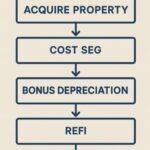Introduction
The real estate investment world got a big win with the passage of the One Big Beautiful Bill (OBBB) on July 4, 2025. This legislation left Section 1031 like-kind exchanges untouched, allowing investors to keep deferring capital gains taxes when swapping investment properties. Earlier proposals, like those in Biden’s 2025 budget, aimed to cap or eliminate these exchanges, but the OBBB’s final version preserved this powerful tool.
This blog explains what didn’t change with the OBBB and why it’s a game-changer for investors. We’ll cover the key 45/180-day deadlines, how to combine 1031 exchanges with cost segregation and bonus depreciation, and the nuances of depreciation recapture. Whether you’re eyeing NNN properties for sale or exploring DST 1031 listings under $1M, this guide will help you navigate the 2025 tax landscape.
What Didn’t Change & Why It Matters
OBBB left Section 1031 untouched. Here’s what stayed the same:
- Full tax‑deferral. Sell investment property. Buy a replacement. Pay zero capital‑gains tax now (Reuters, Jul 19 2025).
- Like‑kind breadth. Any U.S. real estate qualifies. Office to warehouse. Raw land to retail.
- 45/180‑day deadlines. Still mandatory or the deferral fails.
- Qualified intermediaries. You must use one to hold and transfer funds.
Why it matters: Capital‑gains rates top 23.8 percent. Deferring that hits your cash-on-cash. Leaving it intact means you keep more equity working for you.
Stat: In a July 2025 survey, 68 percent of investors said they’d still use a 1031 exchange this year—unchanged from 2024 .
45/180-Day Deadlines Refresher
A 1031 exchange comes with strict IRS timelines: you have 45 days to identify replacement properties and 180 days to complete the purchase. These safe-harbor 1031 timelines are non-negotiable and missing them can void your tax deferral.
| Deadline | Duration | Requirement |
| 45-Day Identification | 45 calendar days from sale | Identify up to three replacement properties in writing to QI |
| 180-Day Exchange | 180 calendar days from sale | Close on replacement property purchase |
In rare cases, like federally declared disasters, the IRS may extend deadlines (Holland & Knight, Jan 2025). Always work with a QI to stay compliant.
Combining 1031 with Cost Seg & Bonus Dep
Pairing a 1031 exchange with a cost-segregation study real estate strategy can supercharge your tax savings. Cost segregation breaks down a property’s components (e.g., fixtures, HVAC) to depreciate them over shorter periods (5 or 7 years) instead of 27.5 or 39 years for real property. This accelerates deductions, lowering your taxable income.
The OBBB also reinstated 100 percent bonus depreciation real estate for 2025, allowing you to deduct the full cost of qualifying assets (e.g., new equipment) in the first year (Molentax, Jul 2025). If your replacement property has $200,000 in bonus-eligible components, you could deduct the entire amount in 2025, slashing your tax bill.
| Strategy | Property Value | Depreciation Deduction | Tax Savings (25% rate) |
| Standard | $1,000,000 | $27,500/year (27.5 yrs) | $6,875/year |
| Cost Segregation | $1,000,000 | $100,000/year (10 yrs) | $25,000/year |
| Bonus Depreciation | $1,000,000 | $1,000,000 (1st year) | $250,000 (1st year) |
Recapture and Depreciation Nuances
Even with a perfect 1031 + bonus dep. strategy, beware depreciation recapture:
- What is recapture? When you eventually sell your replacement property without a subsequent 1031, the IRS “recaptures” the depreciation deductions at a 25 percent rate.
- Mitigation tip: Use a triple net (NNN) 1031 exchange into a single-tenant NNN investment with a long‑term lease. The passive net‑lease income can cushion cash flow and preserve value, delaying recapture.
- DST 1031 listings under $1M in NNN properties often qualify—consider diversifying and limit recapture exposure.
Triple‑Net Cap‑Rate Trends for 2025
Cap rates drive value. Lower cap rates mean higher cost per dollar of NOI.
| Asset Class | Q2 2024 Cap Rate | Q2 2025 Cap Rate |
| Single‑Tenant NNN | 6.5 % | 6.2 % |
| Multi‑Tenant Retail | 7.0 % | 6.8 % |
| Industrial | 5.8 % | 5.6 % |
Single‑tenant NNN deals in Q2 2025 closed at an average cap rate of 6.2 percent—a 0.3 percent drop year‑over‑year .
That yields higher valuations for your replacement property. More value means you can trade up in quality, location, or scale.
Explore 1031-Eligible Properties
Looking for properties to fuel your next 1031 exchange? 1031DealHub offers a range of options, including:
| City | Exchange Link |
| Chicago | Chicago 1031 Exchange Properties for Sale |
| Houston | Houston 1031 Exchange Properties for Sale |
| Phoenix | Phoenix NNN Properties for Sale |
| Dallas | Dallas NNN Properties for Sale |
| Nashville | Nashville 1031 Exchange Properties for Sale |
Frequently Asked Questions
Can I use bonus depreciation on my replacement property after a 1031 exchange?
Yes. Once your replacement property is placed in service, you can run a cost‑segregation study and allocate short‑life assets (5‑ to 15‑year class). Under OBBB, those assets placed in service by December 31, 2025, qualify for 100 percent bonus depreciation. That lets you expense the full cost in Year 1.
How do like‑kind rules still apply after OBBB?
OBBB made no changes to Section 1031. Like‑kind rules still allow any U.S. real estate held for investment or business to swap for any other U.S. real estate. You defer all capital gains tax as long as you meet the 45‑ and 180‑day timelines and reinvest 100 percent of your proceeds.
What is a triple net (NNN) 1031 exchange and why use one?
A triple net (NNN) 1031 exchange moves your proceeds into a single‑tenant property where the tenant covers taxes, insurance, and maintenance. This structure delivers steady passive net‑lease income, reduces landlord responsibilities, and can cushion you against recapture by providing reliable cash flow.
How does a cost‑segregation study real estate work with a 1031 exchange?
After you complete your exchange, hire an engineer to reclassify portions of your replacement building into shorter‑life assets (land improvements, personal property, etc.). You then claim accelerated depreciation and, under current rules, 100 percent bonus depreciation on those assets. This slashes your Year 1 taxable income and boosts cash flow.
What happens if I miss the 180‑day deadline?
If you don’t close on one of your identified replacement properties within 180 calendar days of your sale, the IRS disallows your exchange. Your deferred gain becomes taxable in the year of sale, eliminating your deferral benefit. Always plan ahead to meet this firm deadline.
Can I combine a “1031 exchange retained” deferral with other tax breaks?
Absolutely. You can layer your 1031 exchange with cost segregation and bonus depreciation, if you follow each program’s rules. This strategy lets you defer gains, accelerate deductions, and maximize tax‑advantaged cash flow.
Conclusion
The Section 1031 exchange remains a powerful tool post-OBBB, letting investors defer taxes and grow their portfolios. By mastering the 45/180-day deadlines, leveraging cost segregation and bonus depreciation, and understanding depreciation recapture, you can maximize your returns. Explore 1031 exchange properties for sale to start building your wealth today.
DISCLAIMER
I am not a CPA, attorney, broker-dealer, or investment adviser. This content is for general education and must not be relied upon for tax, legal, or accounting advice. Always consult your licensed professional. Federal and state rules change frequently; info may become outdated. Circular 230 Notice: Nothing here is intended for, nor can it be used for, avoiding U.S. tax penalties.
Advertising Disclosure. Posts may reference services offered by AMC Real Estate Investment Services and affiliates, including 1031DealHub.
Forward-Looking Statements. Any opinions or projections are based on current data and may change without notice.
Ready for passive income? Visit https://1031dealhub.com/ to browse NNN 1031‑eligible properties now.






